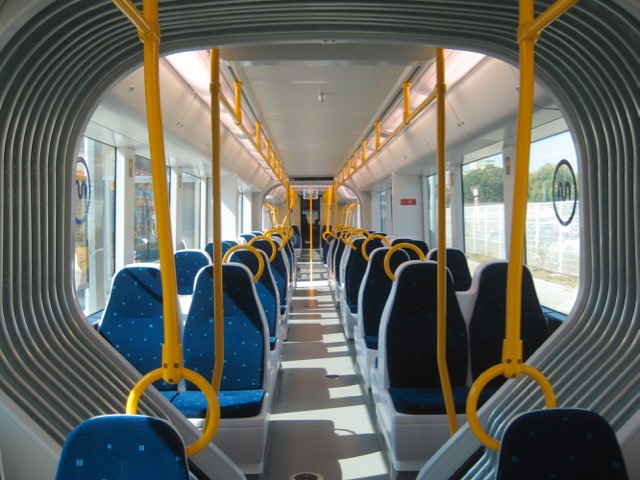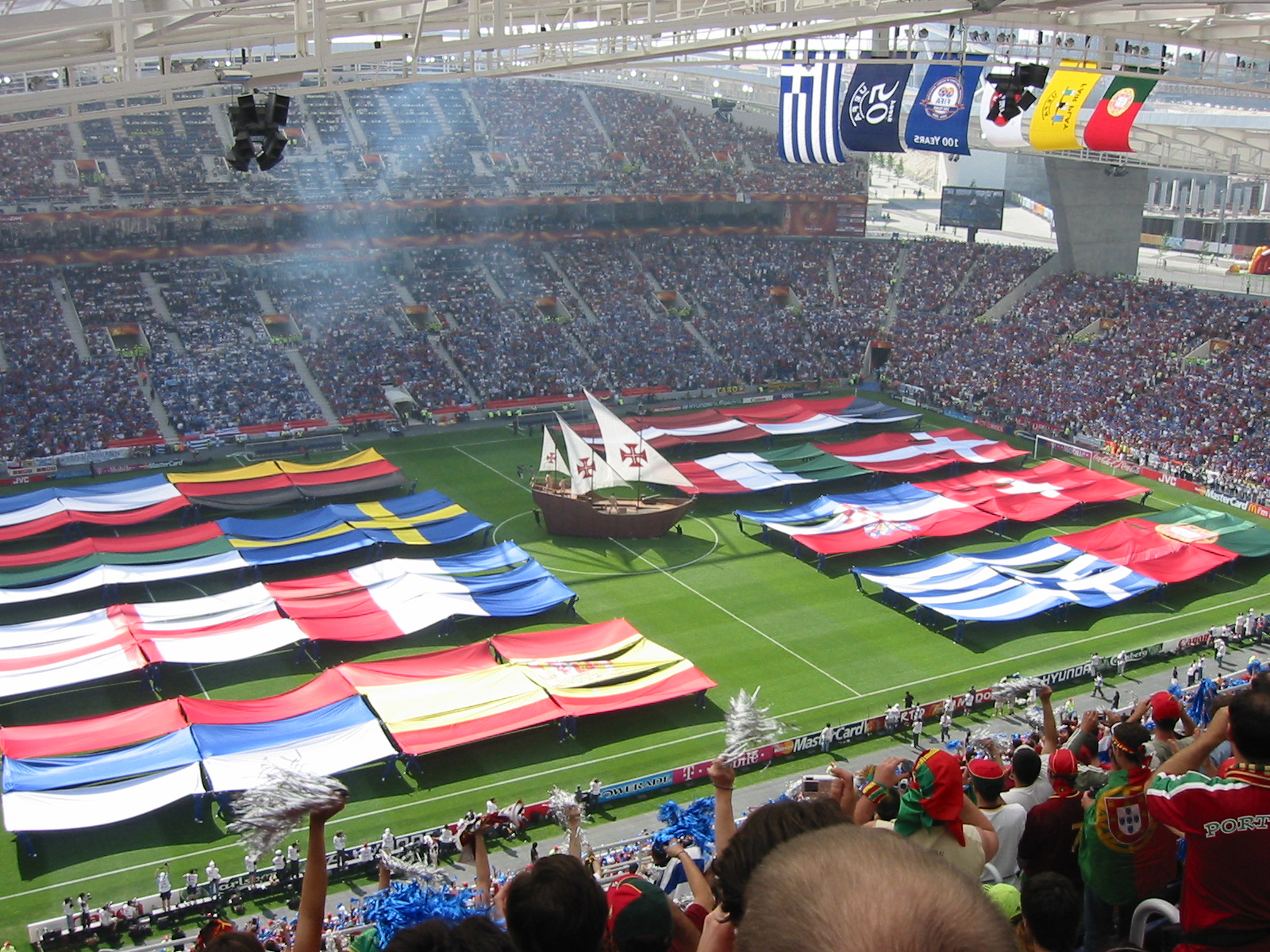|
Estádio Do Dragão Station (Porto Metro)
Estádio do Dragão, known during its planning stage as Antas, is a light rail station on the Porto Metro system in Porto, Portugal. The station is underground, adjacent to the Estádio do Dragão football stadium, from which it takes its name. It was opened in 2004, in time for that year's European Football Championship, for which the stadium hosted games. The station is a through station on line F, and acts as the eastern terminus for trains on lines A, B and E. Lines A, B, E and F run as one line within the metropolitan area to the west of Estádio do Dragão, and the next station in that direction is Campanhã. To the east on line F, the next station is . Estádio do Dragão station station is located underground, between the stadium and the main line railway tracks north out of Campanhã railway station. It has three through tracks served by two island platform An island platform (also center platform (American English) or centre platform (British English)) is a station ... [...More Info...] [...Related Items...] OR: [Wikipedia] [Google] [Baidu] |
Porto Metro
The Porto Metro () is a light rail network in Porto, Portugal and a key part of the city's public transport system. Having a semi-metro alignment, it runs underground in central Porto and above ground into the city's suburbs while using low-floor tram vehicles. The first parts of the system have been in operation since 2002.Webb, Mary (ed.) (2009). ''Jane's Urban Transport Systems 2009–2010'', p. 277. Coulsdon, Surrey (UK): Jane's Information Group. . The network has 6 lines and reaches seven municipalities within the metropolitan Porto area: Porto, Gondomar, Maia, Matosinhos, Póvoa de Varzim, Vila do Conde and Vila Nova de Gaia. It currently has a total of 85 operational stations across of double track commercial line. Most of the system is at ground level or elevated, but of the network is underground. The system is run by ViaPORTO. The Porto Metro has received the Veronica Rudge Green Prize in Urban Design from Harvard University's Graduate School of Design in ... [...More Info...] [...Related Items...] OR: [Wikipedia] [Google] [Baidu] |
Porto
Porto (), also known in English language, English as Oporto, is the List of cities in Portugal, second largest city in Portugal, after Lisbon. It is the capital of the Porto District and one of the Iberian Peninsula's major urban areas. Porto city proper, which is the entire concelho, municipality of Porto, is small compared to its metropolitan area, with an estimated population of just 248,769 people in a municipality with only . Porto's urban area has around 1,319,151 people (2025) in an area of ,Demographia: World Urban Areas , March 2010 making it the second-largest urban area in Portugal. It is recognized as a global city with a Gamma + rating from the Globalization and World Cities Research Network. Located along the Douro River estuary in northern Portugal, Porto is one of the oldest European centers and ... [...More Info...] [...Related Items...] OR: [Wikipedia] [Google] [Baidu] |
Portugal
Portugal, officially the Portuguese Republic, is a country on the Iberian Peninsula in Southwestern Europe. Featuring Cabo da Roca, the westernmost point in continental Europe, Portugal borders Spain to its north and east, with which it shares Portugal-Spain border, the longest uninterrupted border in the European Union; to the south and the west is the North Atlantic Ocean; and to the west and southwest lie the Macaronesia, Macaronesian archipelagos of the Azores and Madeira, which are the two Autonomous Regions of Portugal, autonomous regions of Portugal. Lisbon is the Capital city, capital and List of largest cities in Portugal, largest city, followed by Porto, which is the only other Metropolitan areas in Portugal, metropolitan area. The western Iberian Peninsula has been continuously inhabited since Prehistoric Iberia, prehistoric times, with the earliest signs of Human settlement, settlement dating to 5500 BC. Celts, Celtic and List of the Pre-Roman peoples of the Iberia ... [...More Info...] [...Related Items...] OR: [Wikipedia] [Google] [Baidu] |
Metro Do Porto Linha A
Metro may refer to: Geography * Metro City (Indonesia), a city in Indonesia * A metropolitan area, the populated region including and surrounding an urban center Public transport * Rapid transit, a passenger railway in an urban area with high capacity and frequency * The public transport operator of city or metropolitan area * The transportation authority of city or metropolitan area * The urban rail transit system of a city or metropolitan area Rail systems Africa * Algiers Metro in Algiers, Algeria * Cairo Metro in Cairo, Egypt * Lagos Rail Mass Transit in Lagos, Nigeria Asia * Busan Metro, Republic of Korea (South Korea) * Daegu Metro, Republic of Korea (South Korea) * Dhaka Metro, Bangladesh * Doha Metro, Qatar * Dubai Metro, United Arab Emirates (U.A.E.) * Kaohsiung Rapid Transit, Taiwan * Lahore Metro, Pakistan * Manila Metro Rail Transit System, the Philippines * New Taipei Metro, Taiwan * Osaka Metro, Japan * Riyadh Metro, Saudi Arabia * Seoul Metropolitan Subway, Re ... [...More Info...] [...Related Items...] OR: [Wikipedia] [Google] [Baidu] |
Island Platforms
An island platform (also center platform (American English) or centre platform (British English)) is a station layout arrangement where a single railway platform, platform is positioned between two railway track, tracks within a railway station, tram stop or transitway, transitway interchange. Island platforms are sometimes used between the opposite-direction tracks on twin-track route stations as they are cheaper and occupy less area than other arrangements. They are also useful within larger stations, where local and express services for the same direction of travel can be accessed from opposite sides of the same platform instead of side platforms on either side of the tracks, simplifying and speeding transfers between the two tracks. The historical use of island platforms depends greatly upon the location. In the United Kingdom the use of island platforms on twin-track routes is relatively common when the railway line is in a Cutting (transportation), cutting or raised on an E ... [...More Info...] [...Related Items...] OR: [Wikipedia] [Google] [Baidu] |
Estádio Do Dragão
The Estádio do Dragão (; ') is an all-seater football stadium in Porto, Portugal, and the home ground of FC Porto since 2003. It has a seating capacity of 50,033, making it the third-largest football stadium in Portugal. Designed by Portuguese architect Manuel Salgado, the stadium was constructed to replace Porto's former ground, the Estádio das Antas, along with becoming one of the host venues for the UEFA Euro 2004 final tournament. The inauguration took place on 16 November 2003 with a friendly match against Barcelona, setting an attendance record of 52,000 spectators. A UEFA category four stadium, it has held several international club and national team competition matches, including the 2019 UEFA Nations League Final and 2021 UEFA Champions League Final. The stadium is one of the potential venues for the 2030 FIFA World Cup which Portugal will co-host along with Morocco and Spain. Construction and inauguration Construction works began in late 2001, and were complet ... [...More Info...] [...Related Items...] OR: [Wikipedia] [Google] [Baidu] |
2004 UEFA European Football Championship
The 2004 UEFA European Football Championship, commonly referred to as Euro 2004, was the 12th edition of the UEFA European Championship, a quadrennial football competition contested by the men's national teams of UEFA member associations. The final tournament was hosted for the first time in Portugal, from 12 June to 4 July 2004. A total of 31 matches were played in ten venues across eight cities – Aveiro, Braga, Coimbra, Guimarães, Faro/Loulé, Leiria, Lisbon, and Porto. As in 1996 and 2000, the final tournament was contested by 16 teams: the hosts plus the 15 teams that came through the qualifying tournament, which began in September 2002. Latvia secured their first participation in a major tournament after overcoming Turkey in the play-offs, while Greece returned to the European Championship after 24 years. The tournament was rich in surprises and upsets: traditional powerhouses Germany, Spain, and Italy were eliminated in the group stage, while defending champions F ... [...More Info...] [...Related Items...] OR: [Wikipedia] [Google] [Baidu] |
Campanhã Station (Porto Metro)
Campanhã is a light rail station on the Porto Metro system in Porto, Portugal. The station is on the surface, adjacent to the Campanhã railway station, Porto's principal main line station. It was opened in 2004. The station is a through station on lines A, B, E and F, and acts as the eastern terminus for trains on line C. These lines run as one line within the metropolitan area, and the next station to the west is . To the east, the next station is Estádio do Dragão. Campanhã station is located on the surface, next to the main line railway platforms. It has two through tracks served by two side platform A side platform (also known as a marginal platform or a single-face platform) is a platform positioned to the side of one or more railway tracks or guideways at a railway station, tram stop, or transitway. A station having dual side platforms, ...s. Like other stations in the common section of lines A, B, C, E and F, Campanhã sees a very frequent service, with up to 2 ... [...More Info...] [...Related Items...] OR: [Wikipedia] [Google] [Baidu] |
Campanhã Railway Station
The Campanhã Railway Station () is a 19th-century railway station in the civil parish of Campanhã, in the municipality of Porto, district of Porto. Opened in 1877, it is connected to the Metro do Porto by the adjacent Campanhã metro station, and provides access to local commuter trains to Aveiro, Braga, Guimarães and Marco de Canaveses, Intercity and Alfa Pendular trains to Lisbon, inter-regional trains to Valença (which then provide access to Vigo), and the historical train to Pocinho. History The first plan for a station was presented in 1860, to be built in Esteiro de Campanhã and that connected the Douro line to Minho, through an extension that follows the Campanhã valley to the branches along the Rio Tinto. Initially designated, the ''Estação de caminho de ferro do Pinheiro'' (''Pinheiro Railway Station''), the station at Campanhã was designated for lands occupied by the estates of ''Quinta do Pinheiro'' and ''Quintas do Valado''. In 1872, the current ... [...More Info...] [...Related Items...] OR: [Wikipedia] [Google] [Baidu] |



